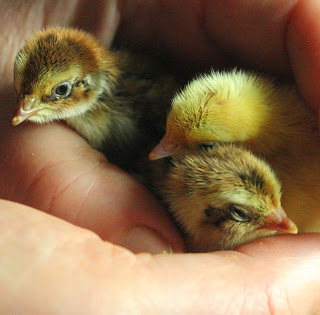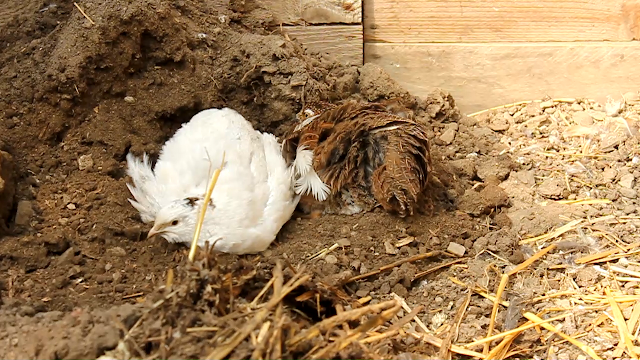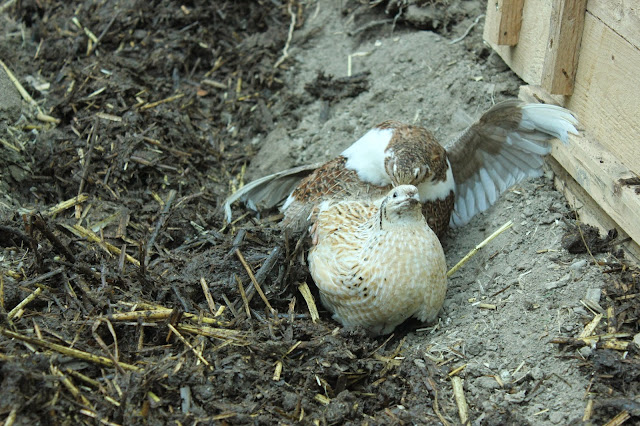I should have remembered that nothing is ever that simple when keeping birds and in particular with our quail. Although I was very optimistic, I did have a nagging doubt about Ginger's choice of nest and nesting site, seemingly rather makeshift, cramped and exposed. However, what eventually happened was totally unexpected.
Three freshly hatched eggs from Ginger's first nest!
On the eighth day of sitting, Ginger came out from behind the pallet shelving looking like she'd had a bad night, her feathers were ruffled and she seemed worried. If you have kept birds for any period of time and observed them closely, you will know that they are sentient beings and portray emotion vocally, facially, in body language and by behaviour. She ate her breakfast and remained out in the main area of the greenhouse and did not return to her nest after the usual 15 - 20 minutes. I decided to remain working in the greenhouse and observe her. After 30 minutes, I reached into the nest and removed four of the (presumed) remaining six eggs from the nest and put them under the Snow Queen. This, if you remember from my previous post, is the bantam Cochin I had prepared as back-up and who was already sitting some more of the other quail's eggs. Ginger did not return to the nest that morning, nor as far as I can tell, at any time later. So I was a bit miffed but pleased she had even made a first attempt and without a specially prepared safe nesting area! Furthermore I was so happy nothing had actually broken into the greenhouse, although, on checking, I found one of the original eggs was missing.
Then three days later I discovered a much more defined nest, it is actually called a scrape. This is made up of a shallow depression dug out in the soil, similar to that the quail make for sleeping but in addition, has bits of dried grass and straw pulled together from the surrounding area. I also noticed that the eggs were 'stored' pointed end downwards and partly buried in the soil. This nest had just three eggs and was hidden under the rosemary bush in exactly the same place as I had found a nest the year before. It seemed a very professional job! Rather than collect the eggs I left them and I am very glad I did as a couple of days later I decided to film them for my photo records and found a whole lot more..
..and not only that but as I was filming, this happened - pretty much a friendly but proprietary gesture by one of my other quail
..and then two days later, Ginger took charge and began to sit.
There are now thirteen eggs in all and Ginger only gets off the nest for a few minutes each day, just when she hears me open the door to bring some extra food. She is also well clamped down onto the nest, this is no mean feat as it is a large clutch, (most papers quoting an average coturnix clutch of 8 to 10 eggs).
Meanwhile, last night, the 13th of May, I was awoken and heard Snow Queen calling to chicks, it is a very obvious call. I went back to sleep almost instantly but this morning when I took her off the nest....
At the moment there are three chicks and my feelings are that these are from the four eggs I took from Ginger's first abandoned nest, as she was sitting a full two days before Snow Queen and we are now on the nineteenth day of what would have been Ginger's incubation. The chicks look like an English White and two Tuxedos but it is rather early to be certain.
I now have several questions and musings.
- the second nest (under the rosemary) is obviously a communal one, it filled up very quickly and there was that 'guarding' gesture by one of my other quail. According to research carried out by Orcutt and Orcutt*, domestic coturnix quail were observed to pair off and become monogamous during courtship, laying and brooding. Therefore, will all these eggs in the nest be fertile?
- the eggs I collected after Ginger had began to sit and put under Snow Queen, were also from quail other than Ginger, so ditto to the above.
- my understanding is female birds remain fertile from one male for at least ten days after mating. This is why, if I want to breed pure Polish, for example, I have to take my hens out of the communal forest garden and keep them away for nearly two weeks before pairing them with one of my Polish roosters/cockerels. It is now the tenth day since Fred went back home!
- technically, even if Fred was monogamous and/or if some of the eggs in the second nest are Ginger's, we could still be expecting a further pattering of tiny claws?
In the event that we have more chicks, I may decide to finesse them under Ginger and let another hen sit the clutch she is now incubating.
Stay tuned.
Now if you'd like to, after all the serious stuff, watch the film in super fluffy vision!
 Thanks for dropping by and if you
have enjoyed this piece and found it useful think about sharing it and
also maybe about joining this blog. Please also feel free to ask
questions or make comments in the section below.
Thanks for dropping by and if you
have enjoyed this piece and found it useful think about sharing it and
also maybe about joining this blog. Please also feel free to ask
questions or make comments in the section below.All the very best,
Sue
RETURN TO CONTENTS PAGE
© Sue Cross 2015
*
Orcutt Scott Jr, F. and Orcutt, A. B. (1976) 'Nesting and Parental Behavior in Domestic Common Quail', The Auk, Vol. 93, No. 1, January, pp. 135-141

















